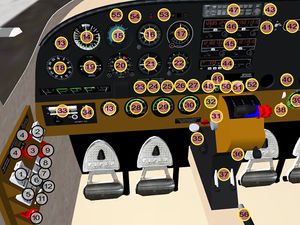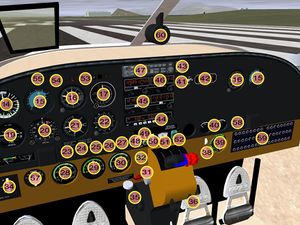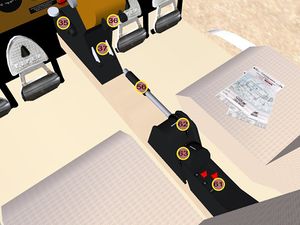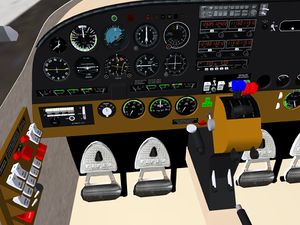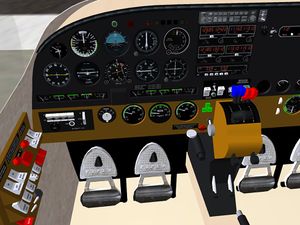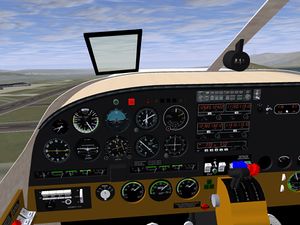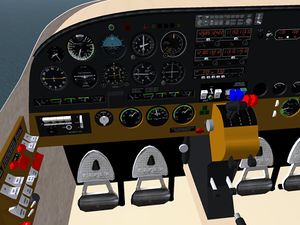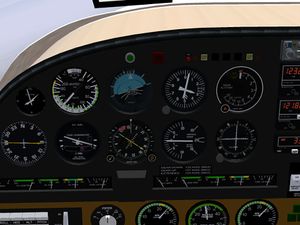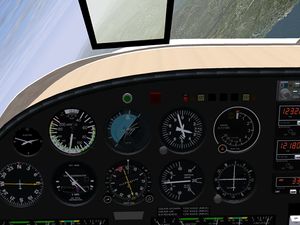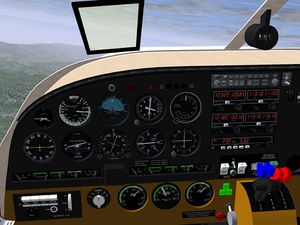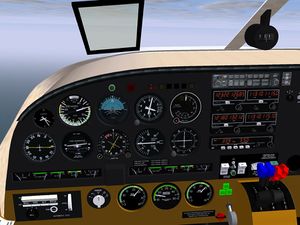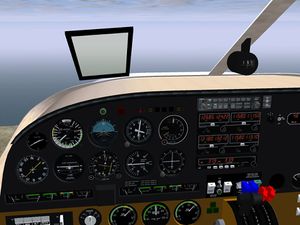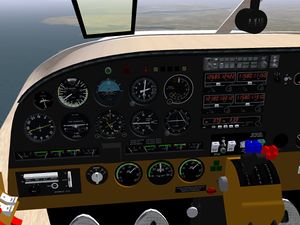Howto:Seneca II
These are basic instructions about how to fly the Seneca II in FlightGear. They should help you finding and operating all controls in the cockpit you need for a flight. You will also learn some basic maneuvers and procedures. They are based on real world flying procedures and should match reality quite close. But do not use this HOWTO as a guide for real-life flying. There are still some differences between reality and virtuality (e.g. there are no keys like P and ESC in real aircraft).
To follow this HOWTO, you need
- A running version of FlightGear
- The Seneca II aircraft from the FlightGear Aircraft download page installed
- The Seneca II Checklist
- The Seneca II Panel Reference
- For the IFR part some IFR charts e.g. from AirNav
- Some spare time: 1 hour for the VFR part, 2 hours for the complete session
The reference screenshots may help, if you are not familiar with the location of the controls:
Basics - VFR
To keep the beginning simple, let's start on a nice sunny day in San Francisco Intl - KSFO, FlightGear's default airport. Start your FlightGear with
fgfs --aircraft=SenecaII
You will be placed on KSFO runway 28R with a dead aircraft blocking the runway.
In reality, you should never sit in this position without being ready for an immediate takeoff - but in our sim everything is fine here. Grab your checklist and go through the Cockpit Check and Before Start Engine lists. Your panel should look similiar to the picture on the right.
Startup, Takeoff, Straight and Level
First of all, we have to start the engines. Once again, the checklist will help us doing the right things in the correct order. The operation of the primer is not needed in the simulation, so you can safely skip the operation of the primer here, since the engines will fire regardless of priming or not. After ignition, you have to open the throttles to let the engines run at more than 1000RPM for a short time to keep them alive. Go through the After Start Engine Check. The Taxi Check is somewhat void here, since we will not taxi. Leave the flaps up - they are not needed on this long runway. The default trim position will work fine for takeoff. When the engines are running, it's time to do the nav setup. We do a straight out departure without navaids, so just twist the heading bug to the runway heading of 280. The center dot of the attitude indicator should align with the horizon line. The Before Takeoff Check will make you set the fuel selectors to on. The clearance for our little training session is: 'Climb on runway heading to 2000ft. Maintain 2000ft until further advice.' That will also serve as a departure briefing. And in case of emergency: hit the ESC key and restart FlightGear.
D-GEAR: cleared for takeoff runway 28R
When cleared for takeoff, advance the throttle slowly to apply 40" of manifold pressure. In reality you should only advance to 39" of manifold pressure, the remaining inch will build up on the run due to ramair. A warning light in the annunciator panel will illuminate if you exceed 40". Reduce throttle on the corresponding engine in that case to avoid engine damage. When MP is stabilized, release the parking brake (⇧ Shift+B) for the takeoff-run. Maintain the centerline and observe the airspeed indicator passing the red line (minimum control speed air) and rotate at 70knots by pulling the yoke (or joystick) a little back. When airborne, accelerate past the blue line (best rate of climb single engine) to 95knots. When the runway is not sufficient for landing anymore, retract the gear and turn off the landing lights.At 500ft above the field reduce the power to 31" manifold pressure and 2500 RPM.Accelerate to 100knots climb speed for a better engine cooling. When your workload permitts, read the After Takeoff Check.
When reaching the target altitude of 2000ft, lower the nose and let the aircraft accelerate for some seconds. Adjust your pitch slowly so the vertical speed indicator shows 0fpm. Reduce the power to 28"/2400RPM. Lean the mixture a little to save some virtual fuel and get best cruise performance. Closing the cowl-flaps (use the 'Seneca' Menuitem) will give you approx. 10knots of additional airspeed.
You should be now on a straight and level flight at 2000ft at some 130 knots. If you want, go to the next section or hit the P key to pause and have a coffee.
Airwork, Turns, Climbs and Descends
OK - Now let's have some fun and leave the boring straight and level thing and go for some airwork. We skip the usual clearing turn here, because we don't care about any other virtual aircraft around us.
Climbs and Descends
D-GEAR on course climb altitude 4000ft, maintain for 1 minute, thereafter descend altitude 3000ft
To climb, the aircraft needs more power and less speed. That means the engines need better cooling, so first thing to do is open the cowl flaps. Climb power will be at 75% max power. The according power setting is 32" manifold pressure and 2500RPM. When increasing power, always increase RPM first before increasing manifold pressure. Increase pitch (pull yoke backwards) to some 5 degrees and slow down to 100 knots indicated. When reaching the target altitude, level off exactly like you did after takeoff. Reduce power to 28"/2400RPM and close the cowl flaps.
After one minute start the descent. Reduce power to 21" and 2300RPM. Reduce manifold pressure before decreasing RPM. Leave the cowl flaps closed to keep the engines warm. Pitch down 3-4 degrees to maintain a rate of descent of 500-1000 feet per minute.
Never descent with an idle engine to avoid shock-cooling and severe engine damage.
When reaching the target altitude of 3000ft, reset power to 28"/2400RPM (remember: increase RPM first), pitch up and accelerate to cruise speed.
Standard Rate Turn
The standart rate turn is defined (for slow aircraft like the Seneca) as turning with a rate of 3 degrees per second. That makes a full circle in 2 minutes. That's why some people call this a 2-minute-turn. The turn coordinator helps you in the correct timing. When the aircraft starts turning (rotate around the vertical axis), the little aircraft symbol starts to bank. When the right wing of that symbol aligns with the R marking, the aircraft turns right at exactly the 3 degrees per second rate. And it works on left turns, too. Just use the L marking and the left wing of the aircraft symbol for that.
So much for the theory - start with a 360 degree turn to the right. Bank to the right, a bank angle of 20 degrees should get you a correct rate of turn. Apply a little right rudder to make the turn coordinated and keep the ball in the turn coordinator instrument centered. Try to keep the altitude within a limit of +/- 100ft (2900-3100ft). Align the altitude with small variations of pitch. Slowly roll out 10 degrees before reaching the target heading of 280.
Stabilize heading 280 and altitude 3000ft and do the same with a left turn.
Steep Turn
This is fun! Steep turn are at 60 degrees bank angle (this is the second long marking on the attitude indicator). In reality this makes you feel the g-force and if you make it perfect, you enter you own wake turbulance when finishing the 360.
The high bank angle reduces the aircraft's lift. This will be compensated with a higher power setting - 1" more manifold pressure will do. Apply the higher manifold pressure when passing 30 degrees of bank angle. In the turn, the elevator becomes more a rudder. Pulling the yoke increases the rate of turn. Adjust the bank angle with the ailerons. Adjust the altitude with the bank angle. Reduce the bank angle when altitude decreases and increase bank angle when the altitude increases. Do not pull the elevator when you loose altitude. That will make things worse.
Now start again with a steep turn to the right. Bank to the right - at 30 degrees bank angle set manifold pressure to 29". Continue increasing the bank angle and pull the yoke. In reality, you need some force here and you feel the increased weight of you body. Keep an eye on the attitude indicator and the altimeter. Try to maintain altitude within +/- 100ft and bank angle of 60 degrees. Roll out on heading 250, reduce manifold pressure to 28" and settle on heading 280 altitude 3000ft. Now try a steep turn to the left. If you are satisfied with the result, try to swing over to the right for another steep turn to the right.
After all these steep turns calm down again, make a standard rate turn to the right for a new heading of 090. This should lead closer to the field.
Slow Flight
At the present altitude of 3000ft and heading 090 reduce the power to 18" manifold pressure. While maintaining altitude 3000ft, the aircraft slows down. At 129 knots or below, lower the landing gear. At 105 knots (white arc begins) lower flaps one, than two and finally three notches to full extension. Let the speed reduce to 80 knots. You now fly a big, clumsy tanker. To maintain your speed and altitude adjust the powersetting by 3 to 4 inches and be careful with the yoke, don't pull to hard - the stall is just around the corner. Try to further reduce speed to 70 knots. Now go for a heading change - turn left heading north. Be very careful, make it shallow and smooth. Only small corrections with the ailerons are allowed and using the rudder is strongly recommended. Its easy to get a stall and end up in a spin. After establishing on heading north, turn right again heading 090, still in slow flight. Is your altitude 3000 ft?
Proceed with a stall in the next section...
Stalls
Approach Stall
The first stall to achieve is the approach stall. This is done in approach configuration: gear down, flaps fully set and low power. The goal is to recover from this stall without any altitude loss, because there is no altitude to loose when approaching a runway and getting into a stall 300ft above ground. The stall is indicated by either
- end of white arc on airspeed indicator
- stall warning
- buffeting
whichever is first.
Since neither stall warning nor buffeting is currently implemented assume a stall at the end of the white arc (61 knots). To recover from the approach stall
- Don't reduce pitch!
- full power (40" manifold pressure, 2575 RPM)
- reduce drag
- gear up
- flaps up to first notch
- when stall is broken: flaps up
- accelerate to best rate of climb speed
- reduce power to climb power
Clean Stall
Clean stalls happen in clean configuration - flaps up and gear up and reduced power. A altitude loss of up to 100ft is acceptable. Stall indicators are
- end of green arc on airspeed indicator
- stall warning
- buffeting
whichever is first.
Recovery is done
- reduce pitch
- full power (40" manifold pressure, 2575 RPM)
- when stall is broken, reduce power to cruise power
Power On Stall
Power on stalls are also in clean configuration but with power either climb or full power. They occur on climbouts on a too high angle of attack. Recovery usually leads to an altitude loss. The stall indicators are
- end of green arc on airspeed indicator
- stall warning
- buffeting
whichever is first.
There is only one way to recover from this stall
- reduce pitch
- accelerate
- when stall is broken, continue climb with lower pitch
Approach and Landing
So you are still alive and flying? Congratiulations. So it's time for a break - let's go home for a landing at KSFO RWY 28R. Reset all controls now for a normal cruise at 28" manifold pressure and 2400RPM at 3000ft. If you didn't do anything bad, you should be somewhere between KSFO and downtown San Francisco with the bay right in front of you heading east (090).
When you have the airport in sight, proceed direct to the field descending altitude 1000ft.
To get home if you are lost, tune the NDB radio to 379, hit the <-> button to enable the frequency and press the ADF button. This is the SF ndb standing a few miles from the airport on the extended centerline of RWY 28. The needle of the NDB indicator points directly to this beacon. Now turn in the direction the needle is pointing until the needle show straight up to N. While on your way, descend altitude 2000ft. This is a good moment for reading the approach check from the checklist.
When the ADF needle starts to move quickly maintain you heading until it has passed the E or W marking. Now you have passed the SF beacon. Turn the shortest way to heading 280 and reduce power to 21" manifold pressure and 2300RPM. Descend at a rate of 500 feet per minute to altitude 1000ft. Follow the costline until you can see the airport, proceed to runway intersection and enter right downwind RWY 28R.
Look out of the right window - when abeam the numbers of the runway, reduce power to 18" manifold pressure, maintain 1000ft. Lower the gear when speed is below 129 knots. Turn on landing lights. Slow down to 105 knots. Look right, when the runway threshold is 45 degrees behind you turn base, set flaps one notch and start descend with 500fpm. You should be at 500ft when turning to final. On final set flaps two notches and reduce to 90 knots. Final check
- gear down and 3 green
- propeller high RPM
- mixture rich
- landing lights on
- speed 90
When sure of making the runway, extend flaps fully. When over the threshold reduce power to idle and level off a few feet above the runway. Pitch up without climbing and let the aircraft settle. Apply breaks to stop and you are done.
OK - this was not a very common approach and it will scare the controllers in the bay area - but who cares in simuland?
Timed Traffic Pattern, Touch and Go, Go Around
Advanced - IFR
Preparing
Flying a SID
Entering and flying the holding
Flying the Approach
Flying the Missed Approach
Abnormal Procedures
Engine Failure
Engine Failure During Takeoff
Engine Failure Enroute
Single Engine Go Around
Related content
- Piper PA34-200T Seneca II
- Seneca II Checklist
- Seneca II Panel Reference
- Joystick Autopilot Bindings Snippets for joystick.xml file that allow control of most of the autopilot functions with the joystick
